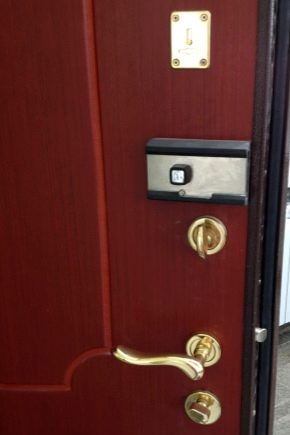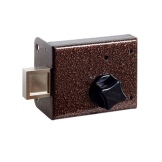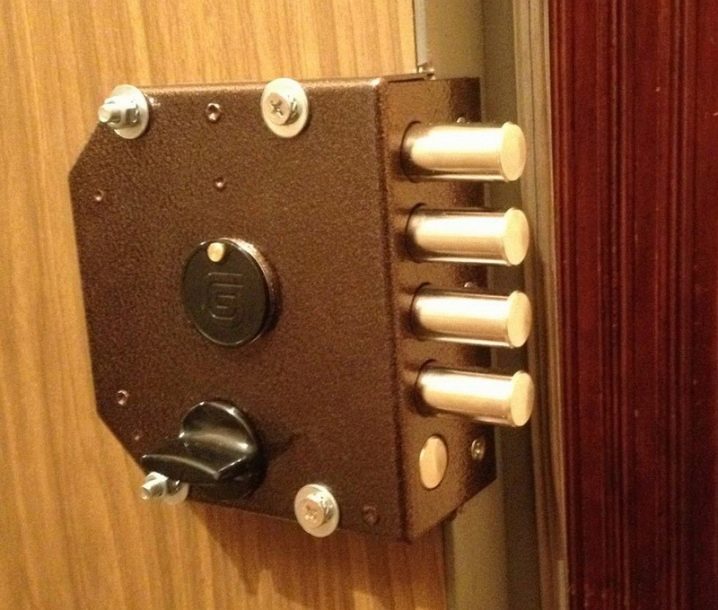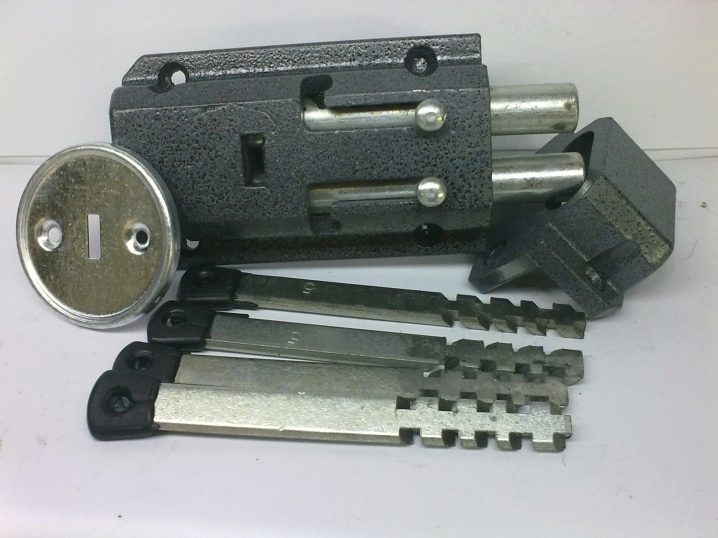Varieties, installation and repair of overhead locks

Overhead door locks are fairly simple designs that you can easily mount yourself. In this article, we will analyze the pros and cons of such devices, consider their types, as well as tips for choosing and installing.

Application area
Surface locks have a wide range of applications among apartment and private house owners. Most of all they are suitable for wooden door leaves, they are mainly installed on entrance doors. Such structures are primarily attracted by the low cost and ease of installation, this type of locks can be installed by hand without much effort.

Much less often they are used with metal doors due to the peculiarities of attachment to metal, where it will be difficult to do without a welding machine and a grinder. For metal doors, the most relevant are mortise locking mechanisms provided by the manufacturer, invoices are used mainly as additional protection against penetration.


Such locks are also great for protecting industrial facilities, shops, offices, where there is a need to install a lock on glass doors. The range of overhead locks on the market for goods in this category is quite large, which will allow you to easily select a device for the needs of each consumer.

Device
Overhead locks are designed very simply, their design implies installation with minimal violation of the integrity of the door, in contrast to built-in locks. The standard set of the lock consists of the main box of the mechanism and the striker. Most models are equipped with a spring latch on the inside and a keyhole on the outside. In these designs, the handle is usually not provided. All locks of this type work on the deadbolt principle, and have several types of internal structure of the mechanism.

Views
Consider the most popular designs on the market.
Among them:
- levers;
- code;
- mechanical;
- electromechanical;




- crossbar;
- "Invisible";
- english;
- rack and pinion.




Suvaldny
Lever type locks are considered the most reliable. The complexity of their device does not allow an attacker to quickly break into the mechanism. The internal locking system of the bolt consists of several plates of complex shapes, which must be correctly positioned in the right order, and at the same time hook the bolt into a special slot in it. The key easily copes with this task. To open it with a master key, you need to try hard and spend a lot of time. In addition, it will not be possible to quietly break the lever lock.

Code
Combination locks are often used on entrance doors or on gates in the courtyards of private houses. There are two types of combination locks: mechanical and electronic. To open mechanical ones, most often you need to hold down a certain number of buttons at the same time. They, as a rule, are not very reliable, given that the material from which the buttons are made can be of poor quality. Buttons, which are constantly clamped, often have characteristic abrasions that make the combination stand out.

Electronic systems, which are often used in intercoms, are considered more reliable. The number of combinations on such locks can be much larger.When the power is turned off, the mechanism is completely blocked, leaving the possibility of emergency opening.
Mechanical
Such overhead locks can be found most often. They are mainly installed on the entrance doors of residential premises. Such structures are unlocked and locked with a key or a special latch.

Electromechanical
Such systems, as a rule, are installed on the gates of courtyards, front doors of offices or other enterprises, since they have the ability to remotely open the door upon request. They often work "in tandem" with intercoms.

Crossbars
Crossbar locks have, perhaps, one of the simplest designs. Unfortunately, they are not very reliable and are suitable for closing garage doors, utility rooms, attics and other rooms where especially valuable things are not stored. Their device does not imply the rotation of the key, and it works on the principle of a latch. The key is inserted into the keyhole and moves linearly relative to the plane of the door. Often the keys for such mechanisms are long, which makes it difficult to carry them in conjunction with the rest. For such keys, it is more difficult to make a duplicate.

Invisible
It is a car lock, where you just need to press a button on the key fob to open it. This type of locking system does not have a keyhole, thus, corresponds to the name "invisible". As a result, it is not possible to open such a lock with a master key. The systems work autonomously, and they are not afraid of a temporary power outage.

English
Such a cylinder lock is very easy to repair and maintain. In the event of a breakdown, its design allows you to replace only the core, instead of replacing the entire mechanism. This also makes it easy to change the key.

Rack
This type of locks is considered the most primitive of the overhead locking mechanisms, along with hinged ones. It is a housing with a rail to which a locking handle is attached inside. From the inside, it works like a regular latch, from the outside, the mechanism is opened and closed with a key. Structures are considered the least resistant to burglary, and are not recommended for protecting apartments, houses and any premises with valuable things inside.

Advantages and disadvantages
The main plus is the simplicity and speed of installation. When installing a patch lock, the integrity of the door leaf is minimally violated, which makes it difficult to try to break the door. In fact, the design, hidden from the eyes of the intruder, does not allow to break the lock mechanically. The structures are completely unpretentious to repair. Another plus is the ability to install a patch lock in places where it is impossible to install a mortise lock, such as insufficient or excessive thickness of the door leaf.

The reliability of overhead locking mechanisms is inferior to many of the mortise ones, which is, perhaps, the main disadvantage. Doors with such locks, closing inward, are much easier for intruders to knock out than to waste time breaking. The presence of a latch instead of a keyhole on the inside of the door is an additional disadvantage, since, having entered the house, an intruder can easily leave the room with valuable things. Also, the disadvantages include the appearance of the door with an installed overhead lock, which can be very conspicuous. The complexity of installation on metal structures is also not a plus.

Installation and replacement rules
Despite the ease of installation, it is worth considering this carefully, because its reliability, durability and ease of use depend on the correct installation of the lock. Such locks should not be installed on doors that open inward, because they will be quite easy to knock out. To install the lock on a wooden canvas, you will need a small set of tools, namely:
- roulette;
- pencil;
- drill or screwdriver;
- a feather drill of a suitable diameter;
- chisel;
- hammer;
- awl.

Installation and replacement rules
First you need to make a markup, adjust the height of the lock. It is worth choosing the most comfortable height for you. There is a certain standard for the location of the castle at a height of 140-150 cm from the floor. To mark the holes, as a rule, a paper template is included in the kit, which is enough to attach at the height of your choice, and then mark the main holes with an awl or a nail. Along the corner marks, it is necessary to drill holes approximately equal to the length of the self-tapping screws that will fasten the mechanism. The center mark in the template is for the keyhole. Here, a feather drill of a diameter suitable for your lock will come into play, usually 22 mm.

Important! You need to make a through hole, but on the other side, where the drill will come out of the door, it can pull out the wood fibers. This can often ruin the door. Therefore, on the back side, it is worth attaching a small block and pressing it firmly against the door until the hole is completely drilled.
Further, everything is extremely simple. It remains only to insert the lock into the resulting hole, align the marking holes, and screw it with self-tapping screws. For reliability, it is recommended to use screws 5 mm shorter than the blade thickness. This is followed by the installation of the striker, and here everything is even easier. You just need to align the bar so that the lock bolt goes into the hole without difficulty, and set the marks with a pencil. It is also necessary to outline the bolt hole on the door frame. After that, using a chisel, a hole is hollowed out along the marked contour, and holes are drilled for fasteners.

After installing the striker, all that remains is to press the ring onto the keyhole. In most cases, this can be dealt with with a hammer. Some designs allow rings to be wound or they may already be installed. When all the above steps are completed, the installation of the lock can be considered complete. With metal doors, everything is a little more complicated, if the manufacturer does not provide a mount for an additional lock.

In the event of a necessary replacement, dismantling is not a problem, and is carried out in the same way in the reverse order, excluding the marking. Regardless of whether full or partial replacement of the lock is required.
Repair
Several factors can cause a breakdown. For example, non-compliance with the rules of operation, wear of parts, mechanical stress, improper installation, displacement of the door leaf, marriage, or a broken key left in the keyhole. Depending on the problem, the solutions may vary. In some cases, it is recommended to replace the entire lock. A big plus during repairs is the ability to easily disassemble and assemble the case. Often after that, the problem is immediately visible, and the solution does not take much time.

It is advisable to foresee possible breakdowns during the purchase, and choose a lock that makes it possible to replace only the core. Often the incomplete operability of the mechanism is solved by a simple adjustment. You can always contact a specialist. Also, shops almost always provide a guarantee. The most effective option is to replace the lock, since it can be quite difficult to find components, and a self-repaired element breaks down again after a while.

Selection Tips
A large assortment of overhead locks can bring some difficulties when choosing. To begin with, it is worth deciding how and where the mechanism will be used: on the front door to a house or apartment, garage doors or office doors. It is also necessary to take into account the type of door leaf: metal, wooden or glass door. Remembering the above, you can easily determine which design will be the most reliable. It is also important to pay attention to the quality of materials and workmanship. A good lock will be quite weighty, there are no backlashes, creaking and crackling inside.An excellent option is constructions with a steel body, they differ in build quality, and are quite resistant to damage.

Cast iron housings are also in demand. They have a large margin of safety, they are also resistant to damage, however, this metal reacts poorly to low temperatures, and can burst in severe frosts.
It is preferable to take the lock of a popular brand, such companies, as a rule, are in high demand, having established themselves as one of the most reliable. It is necessary to carefully study all the functions of the lock: despite the simplicity of the design, their buttons can have several purposes. For example, you can block the ability to open with a key. Each model has its own characteristics, and it is worth contacting the seller for advice.

If your priority is the average price, you need to pay attention to the middle price segment, excluding the purchase of cheap models. Cheap locks have significantly shorter service lives, and they are more difficult to repair in the future. Locks are not bought every week, and savings on their own security, as a rule, do not lead to anything good.
For information on how to repair overhead locks with your own hands, see the next video.













The comment was sent successfully.